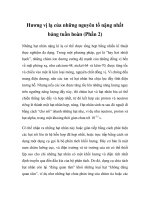Designing Optical Fibers for WDM Applications phần 2 pdf
Bạn đang xem bản rút gọn của tài liệu. Xem và tải ngay bản đầy đủ của tài liệu tại đây (820.93 KB, 10 trang )
Group Delay
~ 4914230 ps / km
(constant)
~ - 81 ps / km-nm
Dispersion
Dispersion Slope
~ 0.24 ps/km-nm^2
Effective Area
~ 31 um^2
Simulation Parameters to Design an Optical Systems Using this Fiber
at 1550 nm
n(core) n(clad) Radius Group Delay GVD GVD Slope Aeff Petermann-2 (MFD)
(um) (ps / km)
(ps / km-nm)
(ps / km-nm^2)
(um^2) (um)
1.46694 1.44402 1.10 NA -50 NA NA 6.0
1.47188 1.44402 0.92 NA -65 NA NA 6.0
1.47866 1.44402 0.775 NA -80 NA NA 6.0
1.46694 1.44402 1.10 4917850 -53 0.07 31 6.0
1.47188 1.44402 0.92 4915340 -67 0.26 34 6.18
1.47866 1.44402 0.7748 4914080 -81 0.24 31 6.0
Fiber_CAD
Reference
Reference : M.Basu, Ramanand Tewari & H.N.Acharya, Optics Communications, Vol.174 (2000), 119-125
Fiber 1 Fiber 2 Fiber 3
NA : Not Available
Why Higher Negative DCF ?
Dispersion Compensation Equation
0Dl Dl
+− −−
+=
or,
(/)lDlD
−++−
=−
l
−
to be small,
D
−
Should be LARGE
Example: At 1550 nm for a SMF* : Dispersion coefficient ~ 17 ps/km-nm
Total dispersion ~ 1700 ps/nm for 100 km of SMF
IF, for a DCF , Dispersion coefficient ~ -17 ps/km-nm
Requires 100 km of DCF
Increases system cost
Therefore
* For specific fiber vendor information, please contact Optiwave Corporation
Theoretical
Experiment
Electronics Letters, Vol. 6, No.2, Sept. 2000
Fiber_CAD
First Core Radius / R.I. : 1 . 34 um / 1 . 469
Second Core Width / R.I. : 6 . 6 um / 1.451
Distance between the cores : 9 . 36 um
Fiber Parameters
Fiber Parameters
First Core Radius / R.I. : 1 . 34 um / 1 . 4685
Second Core Width / R.I. : 6 . 6 um / 1.451
Distance between the cores : 9 . 36 um
Electronics Letters, Vol. 6, No.2, Sept. 2000
D = -1790 ps /km-nm
at 1558 nm
Fiber_CAD
D = -1822 ps /km-nm
at 1560 nm
Simulation Parameters to Design an Optical Systems Using this Fiber
Dispersion ~ - 1630 ps / nm-km
Dispersion Slope ~ -95.4 ps /nm^2-km
Group Delay ~ 4930770 ps/ km
Aeff ~ 55.5 um^2
At 1557 nm (~192.54 Thz)
Why Broadband DCF ?
Compensation of Dispersion
Entire C – band or / and Entire L - band
(/)
dcf dcf tf tf
SDDS=− ×
Complete Dispersion and Slope Compensation
dcf
S
dcf
D
tf
D
tf
S
: Dispersion slope of dispersion compensation fiber
: Dispersion of the dispersion compensation fiber
: Dispersion of the transmission fiber
: Dispersion slope of the transmission fiber
Fiber Parameters
Core Radius / R.I. : 1 um / 1 . 4775
Width of Depressed Cladding / R.I. : 1 . 8 um / 1 . 4375
Simulation Parameters for Designing Optical Systems Using this Fiber
- 213 to -186 ps / km-nm from 1530 to 1625 nm Dispersion :
u
p Delay : 4946140 to 4927090 ps / km from 1530 to 1625 nm
Dispersion Slope : -0.28 ps / km-nm^2 (constant)
Effective Area : 47.5 to 72.5 um^2 from 1530 to 1625 nm
Why (+D) NZDSF with Large Effective Area ?
Dispersion
C-Band L-Band
1550 nm
+D NZDSF
D NZDSF
DSF : # Only for single wavelength transmission at 1550 nm – For DWDM application – NOT SUITABLE
# Nonlinear phenomena like Four Wave Mixing (FWM), is dominant when dispersion is ZERO
(+D) NZDSF and (-D) NZDSF : # Dispersion is finite (2-10 ps / km-nm) in C and L-bands
# FWM is greatly reduced enabling less channel spacing
# Cross Phase modulation (XPM) can be reduced by taking large effective
Area
# Smaller dispersion slope to provide broad transmission window
DSF









